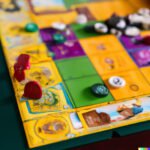Are you looking for a timeless classic board game to add to your collection? Look no further than the Sorry Classic Edition Board Game. This beloved game has been entertaining players of all ages for generations, and it continues to be a favorite among families and friends. Whether you’re a seasoned player or new to the game, Sorry is sure to provide hours of fun and excitement.
The Sorry Classic Edition Board Game has a rich history and origins that date back to its creation in the early 1930s. As one of the most popular board games of all time, Sorry has become a staple in many households and remains a go-to choice for game nights and gatherings. From its humble beginnings to its enduring appeal, there’s no denying the impact that Sorry has had on the world of board games.
In this article, we’ll delve into the fascinating history and origins of Sorry Classic Edition Board Game, explore its components, learn how to play, uncover winning strategies and tips, discover variations and spin-offs, and examine its presence in pop culture. So if you’re curious about what makes Sorry such a timeless classic, keep reading as we take a deep dive into this iconic board game.
History and Origins of Sorry Classic Edition Board Game
The Sorry Classic Edition Board Game has a rich history that dates back to the early 20th century. The game was invented in England in 1929 by William Henry Storey and popularized in the United States by Parker Brothers. The original concept of the game was inspired by an ancient Indian game called Pachisi, which is still played today. Over the years, Sorry has become a beloved classic among board game enthusiasts and families alike.
Sorry Classic Edition was designed as a variation of the original Sorry game, which had been patented in England in 1929 as “Sorry.” The exclamation mark was included at that time. In February 1930, Sorry was trademarked in England, sorry classic edition board games are sold all over the world – from North America to Europe and beyond. Its enduring popularity is a testament to its staying power as an enjoyable and engaging board game for people of all ages.
In recent decades, Sorry Classic Edition Board Game has seen a resurgence in popularity due to its nostalgic appeal and simple yet strategic gameplay. Despite being nearly a century old, the game continues to be a staple in family game nights and has also found new life through digital adaptations and online versions. With its enduring legacy, it’s clear that Sorry Classic Edition Board Game will continue to be cherished by generations to come.
| Country | Year of Patent |
|---|---|
| England | 1929 |
| North America | 20th Century |
| Europe | N/A (Widely distributed) |
Components of Sorry Classic Edition Board Game
The Sorry Classic Edition Board Game is a timeless classic that has been enjoyed by families for generations. In this section, we will take a closer look at the components that make up this beloved game.
The Sorry Classic Edition Board Game includes a game board, 16 pawns in 4 colors, a deck of cards, and the rules of play. The game board features the iconic track with colored spaces representing the path each player’s pawns must take to reach safety. The pawns themselves are simple yet sturdy plastic pieces that fit neatly into their respective starting areas and can be moved around the board according to the cards drawn from the deck.
The deck of cards is an essential component of Sorry Classic Edition Board Game as it dictates how players can move their pawns around the board. The deck contains numbered cards as well as special “Sorry” cards that allow players to send opponents’ pawns back to start or switch places with them. Understanding and strategizing with these cards is key to success in the game.
Overall, the components of Sorry Classic Edition Board Game are carefully designed to ensure a fun and engaging playing experience for all ages. It’s no wonder that this classic game has remained popular over the years and continues to bring joy to countless households around the world.
| Component | Description |
|---|---|
| Game Board | Features iconic track with colored spaces |
| Pawns | 16 pawns in 4 colors, plastic pieces |
| Cards | Deck with numbered and “Sorry” cards |
| Rules of Play | Included for easy reference |
How to Play Sorry Classic Edition Board Game
Sorry Classic Edition Board Game is a fun and exciting game that has been enjoyed by families and friends for generations. The game is easy to learn and can provide hours of entertainment. In this section, we will discuss the basic rules and mechanics of playing Sorry Classic Edition Board Game.
Setup
To begin playing Sorry Classic Edition Board Game, each player selects a color and takes their four pawns from the Start space. The deck of cards should be shuffled, and each player is dealt five cards to start the game.
Gameplay
Players take turns drawing a card from the deck and following the instructions on the card. The main objective of the game is to move all four of your pawns from Start to Home. Players can move their pawns according to the number on the card drawn, with special moves allowed for certain cards.
Special Cards
There are several special cards in Sorry Classic Edition Board Game that add excitement to the gameplay. For example, players can use “Sorry” cards to bump an opponent’s pawn back to Start, “Slide” cards to move forward or backward through different slides on the board, and “11” cards that allow players to switch places with an opponent’s pawn.
By understanding these basic rules and mechanics, players can quickly get started with Sorry Classic Edition Board Game and enjoy hours of fun with family and friends.
Strategy and Tips for Winning Sorry Classic Edition Board Game
When playing the Sorry Classic Edition Board Game, having a good strategy is essential for increasing your chances of winning. Here are some tips and strategies to help you come out on top in this classic board game:
1. Plan Ahead: One of the most important strategies in Sorry is to plan your moves ahead of time. Take the time to consider all your options before making a move, as this can help you make the best decision and avoid unnecessary setbacks.
2. Use Your Sorry Cards Wisely: The Sorry cards are powerful tools that can help you send your opponents’ pawns back to their start position. Use them strategically to not only advance your own pawns, but also to hinder your opponents’ progress.
3. Block Your Opponents: In Sorry, it’s crucial to be aware of where your opponents’ pawns are and how close they are to reaching home. Blocking their path whenever possible can throw a wrench in their plans and give you an advantage.
By following these tips and strategies, you can improve your chances of winning the Sorry Classic Edition Board Game and have a more enjoyable gaming experience.
Whether you’re playing with friends or family, having a solid strategy can make all the difference in coming out victorious in this beloved classic board game. So next time you bring out the Sorry Classic Edition Board Game for game night, remember these tips and put them into practice for a better chance at claiming victory.
Variations and Spin-Offs of Sorry Classic Edition Board Game
Modern Versions and Editions
Since its original release, the Sorry Classic Edition Board Game has seen numerous variations and spin-offs. Modern versions of the game have included different themes and licensed characters to appeal to a wider audience. From special editions featuring popular movies or TV shows to limited run anniversary editions, there is a Sorry board game for every interest. These modern variations often include unique gameplay elements or special components that add a fresh twist to the classic game.
Digital Adaptations
In addition to physical board games, Sorry Classic Edition has also made its way into the digital realm. Various video game adaptations and mobile app versions of the game have been developed, allowing players to enjoy Sorry on their phones, tablets, or gaming consoles. These digital adaptations often offer new features such as online multiplayer modes, customizable rules, and themed boards based on popular franchises.
Educational and Learning Versions
To cater to educational settings, there are also learning-focused adaptations of Sorry Classic Edition Board Game available. These versions may incorporate elements of math, language arts, or history into the gameplay in order to make learning more engaging for students. Educational spin-offs of Sorry can be found in classrooms and homeschooling environments as a fun way to reinforce academic concepts while enjoying a classic board game experience.
Sorry Classic Edition Board Game in Pop Culture
Sorry Classic Edition Board Game has made its mark in pop culture over the years, appearing in various forms of media and entertainment. From television shows to movies, this beloved game has found its way into the hearts of many and has become a staple in popular culture.
- The popular TV show “The Big Bang Theory” featured an episode where the characters played Sorry Classic Edition Board Game, showcasing its nostalgic and entertaining appeal to audiences.
- In the movie “Despicable Me,” the iconic scene where Gru plays Sorry Classic Edition Board Game with the girls not only adds comedic relief but also highlights the universal enjoyment of playing this classic board game.
- The board game has also been referenced in numerous songs, literature, and other forms of entertainment, solidifying its place in pop culture history.
Furthermore, Sorry Classic Edition Board Game has inspired various merchandise, including clothing items, accessories, and even home decor. Its recognizable game pieces and colorful board have become iconic symbols that are instantly associated with timeless fun and enjoyment.
In addition to its appearances in media and merchandise, the influence of Sorry Classic Edition Board Game can be seen in social gatherings and events. Whether it’s a family game night or a casual get-together with friends, this classic board game continues to bring people together through laughter, competition, and cherished memories. Its enduring presence in pop culture is a testament to its timeless appeal and widespread appreciation.
Conclusion
In conclusion, the Sorry Classic Edition Board Game has stood the test of time and remains a beloved classic for families and friends to enjoy. With its simple yet engaging gameplay, rich history, and enduring popularity, it’s no wonder that this game has continued to be a staple in many households for generations.
The Sorry Classic Edition Board Game‘s origins date back to the early 20th century, with its evolution reflecting changes in society and culture over the years. Despite numerous variations and spin-offs, the core gameplay of Sorry has remained consistent, providing players with a familiar and enjoyable experience each time they play.
Furthermore, the Sorry Classic Edition Board Game’s presence in pop culture further solidifies its status as a timeless classic. Whether it’s featured in movies, television shows, or referenced in popular media, Sorry continues to capture the hearts of audiences around the world. As such, it’s clear that the Sorry Classic Edition Board Game will continue to be a cherished favorite for years to come.
Frequently Asked Questions
Is Sorry a Good Board Game?
Sorry is a classic board game that has been enjoyed by many people for generations. It involves strategy, luck, and some level of competition, making it a good option for game nights with family or friends.
How Old Is the Board Game Sorry?
The board game Sorry was first introduced in the United States in 1934 by W.H. Storey & Co before being acquired and released by Parker Brothers in 1935. This makes the game over 85 years old, but its popularity has endured through the decades.
How Do You Play Classic Sorry?
Classic Sorry is played by two to four players who each have four pawns of their chosen color. The objective is to move all your pawns from Start to Home by drawing cards and strategically moving around the board while trying to bump opponents’ pawns back to their Start positions. The first player to get all their pawns home wins.

I love playing all kinds of games – from classics like Monopoly to modern favourites like Ticket to Ride.
I created this blog as a way to share my love of board games with others, and provide information on the latest releases and news in the industry.





